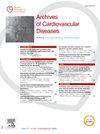Role of endothelial cells and angiogenesis in cardiomyocyte survival under ischemic stress in a 3D spheroid model
IF 2.3
3区 医学
Q2 CARDIAC & CARDIOVASCULAR SYSTEMS
引用次数: 0
Abstract
Introduction
Endothelial cells play a crucial role in the function of the majority of tissues in the body, including cardiac tissue. Their ability to regulate angiogenesis, inflammation, and vascular remodeling makes them essential for cardiac tissue homeostasis and repair. Numerous studies support the idea that the inclusion of endothelial cells in 3D cardiac tissue models could significantly enhance cardiomyocyte survival and overall tissue function.
Objective
The present study aimed to generate cardiac spheroids using cardiomyocytes and fibroblasts, with or without endothelial cells, to investigate the potential of endothelial cells in protecting cardiac spheroids from ischemic stress.
Method
Cardiac spheroid was generated using human primary cardiac fibroblasts, human primary endothelial cells and human cardiomyocytes derived from induced pluripotent stem cells, at a ratio of 1.5:1.5:7, in a spindle-shaped plate. As a control, cardiac spheroid without endothelial cells were also generated. The spheroids were then exposed to an ischemic stress model developed in the laboratory, which combines hypoxia, nutrient deprivation and inflammatory stresses.
Results
The spheroids were analyzed 3 days after exposure to ischemic stress. The presence of endothelial cells not only enhanced cardiomyocyte survival, as evidenced by TUNEL staining, but also improved the structural organization of contractile proteins. Furthermore, the presence of endothelial cells in the spheroid protected the contractile function of cardiomyocytes against ischemic stress. Importantly, treatment with the angiogenesis inhibitor, angiostatin, reversed both the functional and structural improvements induced by endothelial cells, highlighting their essential role in preserving cardiomyocyte integrity under stress.
Conclusion
In conclusion, the presence of endothelial cells in the cardiac spheroids provides essential structural and functional support to cardiomyocytes. More importantly, our results suggest that the 3D organization of endothelial cells and angiogenesis are key factors driving the observed improvements.
内皮细胞和血管生成在缺血应激下心肌细胞存活中的作用
内皮细胞在包括心脏组织在内的人体大多数组织的功能中起着至关重要的作用。它们调节血管生成、炎症和血管重塑的能力使它们对心脏组织的稳态和修复至关重要。大量研究支持这样一种观点,即在三维心脏组织模型中加入内皮细胞可以显著提高心肌细胞存活率和整体组织功能。目的利用心肌细胞和成纤维细胞制备类心脏细胞,观察内皮细胞对类心脏细胞缺血应激的保护作用。方法将人原代心脏成纤维细胞、人原代内皮细胞和诱导多能干细胞衍生的人心肌细胞按1.5:1.5:7的比例在纺锤形板上制备心脏球体。作为对照,不含内皮细胞的心脏球体也被生成。然后将球体暴露在实验室开发的缺血应激模型中,该模型结合了缺氧,营养剥夺和炎症应激。结果缺血应激后第3天对球体进行分析。内皮细胞的存在不仅提高了心肌细胞的存活率(TUNEL染色),而且改善了收缩蛋白的结构组织。此外,球体中内皮细胞的存在保护心肌细胞免受缺血应激的收缩功能。重要的是,血管生成抑制剂血管抑制素治疗逆转了内皮细胞诱导的功能和结构改善,突出了它们在应激下保持心肌细胞完整性的重要作用。结论内皮细胞的存在为心肌细胞提供了必要的结构和功能支持。更重要的是,我们的结果表明,内皮细胞的三维组织和血管生成是推动观察到的改善的关键因素。
本文章由计算机程序翻译,如有差异,请以英文原文为准。
求助全文
约1分钟内获得全文
求助全文
来源期刊

Archives of Cardiovascular Diseases
医学-心血管系统
CiteScore
4.40
自引率
6.70%
发文量
87
审稿时长
34 days
期刊介绍:
The Journal publishes original peer-reviewed clinical and research articles, epidemiological studies, new methodological clinical approaches, review articles and editorials. Topics covered include coronary artery and valve diseases, interventional and pediatric cardiology, cardiovascular surgery, cardiomyopathy and heart failure, arrhythmias and stimulation, cardiovascular imaging, vascular medicine and hypertension, epidemiology and risk factors, and large multicenter studies. Archives of Cardiovascular Diseases also publishes abstracts of papers presented at the annual sessions of the Journées Européennes de la Société Française de Cardiologie and the guidelines edited by the French Society of Cardiology.
 求助内容:
求助内容: 应助结果提醒方式:
应助结果提醒方式:


